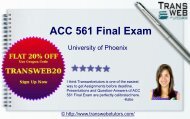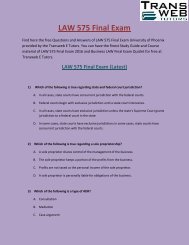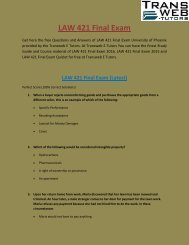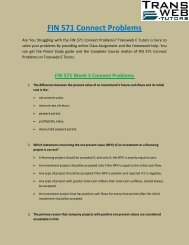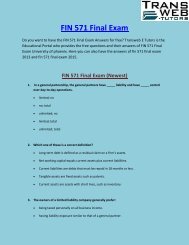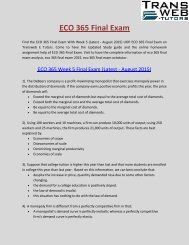ECO 561 Final Exam - ECO 561 Final Exam Answers - Transweb E Tutors
Find here the Questions-Answers set of ECO 561 Final Exam provided by the Transweb E Tutors for free. If you want to have the Complete Study Guide and the Course material ECO 561 Final Exam 39 Questions, ECO 561 Final Exam 1, ECO 561 Final Exam 2013 and ECO 561 Final Exam 2016 then Transweb E Tutors is right place for you. http://www.transwebetutors.com/university-of-phoenix/ECO-561.html
Find here the Questions-Answers set of ECO 561 Final Exam provided by the Transweb E Tutors for free. If you want to have the Complete Study Guide and the Course material ECO 561 Final Exam 39 Questions, ECO 561 Final Exam 1, ECO 561 Final Exam 2013 and ECO 561 Final Exam 2016 then Transweb E Tutors is right place for you.
http://www.transwebetutors.com/university-of-phoenix/ECO-561.html
You also want an ePaper? Increase the reach of your titles
YUMPU automatically turns print PDFs into web optimized ePapers that Google loves.
<strong>ECO</strong> <strong>561</strong> <strong>Final</strong> <strong>Exam</strong><br />
Here <strong>Transweb</strong> E <strong>Tutors</strong> offers Complete Questions-answers of <strong>ECO</strong> <strong>561</strong> <strong>Final</strong> <strong>Exam</strong> for<br />
free. Get the complete Study Guide and the Class Assignment for the <strong>ECO</strong> <strong>561</strong> <strong>Final</strong><br />
<strong>Exam</strong> online at the <strong>Transweb</strong> E <strong>Tutors</strong>. You can also have the <strong>ECO</strong> <strong>561</strong> <strong>Final</strong> <strong>Exam</strong> 2013<br />
and <strong>ECO</strong> <strong>561</strong> <strong>Final</strong> <strong>Exam</strong> 2016 answers for free.<br />
<strong>ECO</strong> <strong>561</strong> Week 6 <strong>Final</strong> <strong>Exam</strong> - <strong>ECO</strong> <strong>561</strong> <strong>Final</strong> <strong>Exam</strong> (100% Correct)<br />
1. Suppose that in the clothing market, production costs have fallen, but the<br />
equilibrium price and quantity purchased have both increased. Based on<br />
this information you can conclude that<br />
A. the supply of clothing has grown faster than the demand for<br />
clothing<br />
B. demand for clothing has grown faster than the supply of clothing<br />
C. the supply of and demand for clothing have grown by the same<br />
proportion<br />
D. there is no way to determine what has happened to supply and<br />
demand with this information<br />
2. Camille's Creations and Julia's Jewels both sell beads in a competitive<br />
market. If at the market price of $5, both are running out of beads to sell<br />
(they can't keep up with the quantity demanded at that price), then we<br />
would expect both Camille's and Julia's to:<br />
A. raise their price and reduce their quantity supplied<br />
B. raise their price and increase their quantity supplied<br />
C. lower their price and reduce their quantity supplied<br />
D. lower their price and increase their quantity supplied
3. In which of the following industries are economies of scale exhausted at<br />
relatively low levels of output?<br />
A. Aircraft production<br />
B. Automobile manufacturing<br />
C. Concrete mixing<br />
D. Newspaper printing<br />
4. The average cost curves (AVC and ATC) should be minimized<br />
A. where MC = ATC and MC = AVC<br />
B. where FC = ATC and FC = AVC<br />
C. where TC starts to increase at a faster rate<br />
D. where ATC = AVC<br />
5. If the wage rate increases,<br />
A. a purely competitive producer will hire less labour, but an<br />
imperfectly competitive producer will not<br />
B. an imperfectly competitive producer will hire less labour, but a<br />
purely competitive producer will not<br />
C. a purely competitive and an imperfectly competitive producer will<br />
both hire less labour<br />
D. an imperfectly competitive producer may find it profitable to hire<br />
either more or less labour<br />
6. The real wage will rise if the nominal wage<br />
A. falls more rapidly than the general price level<br />
B. increases at the same rate as labor productivity<br />
C. increases more rapidly than the general price level<br />
D. falls at the same rate as the general price level
7. Construction workers frequently sponsor political lobbying in support of<br />
greater public spending on highways and public buildings. One reason<br />
they do this is to<br />
A. restrict the supply of construction workers<br />
B. increase the elasticity of demand for construction workers<br />
C. increase the demand for construction workers<br />
D. increase the price of substitute inputs<br />
8. Paying an above-equilibrium wage rate might reduce unit labour costs by<br />
A. permitting the firm to attract lower-quality labour<br />
B. increasing the cost to workers of being fired for shirking<br />
C. increasing voluntary worker turnover<br />
D. increasing the supply of labour<br />
9. A good real-world example of monopolistic competition is<br />
A. lawyers<br />
B. gas stations<br />
C. Time Warner Cable<br />
D. groceries store<br />
10. An industry comprising a small number of firms, each of which considers<br />
the potential reactions of its rivals in making price-output decisions, is<br />
called<br />
A. monopolistic competition<br />
B. oligopoly<br />
C. pure monopoly<br />
D. pure competition
11. Price is constant or given to the individual firm selling in a purely<br />
competitive market because<br />
A. the firm's demand curve is downward sloping<br />
B. of product differentiation reinforced by extensive advertising<br />
C. each seller supplies a negligible fraction of total supply<br />
D. there are no good substitutes for its product<br />
12. The most important pricing strategy for a perfectly competitive firm is<br />
A. minimizing cost<br />
B. maximizing sales<br />
C. product differentiation<br />
D. advertising<br />
13. Which of the following is a non price barrier of entry?<br />
A. Huge sunk cost<br />
B. Discounts<br />
C. Product differentiation<br />
D. Advertising<br />
14. A third-degree price discrimination can be applied to which of the<br />
following market structures?<br />
A. A monopoly<br />
B. An oligopoly<br />
C. A monopolistic competition<br />
D. A perfect competition<br />
15. Investing in R&D is more likely to occur in markets where<br />
A. firms have monopoly power protected by regulatory barriers
B. markets are closely competitive markets with close to zero economic<br />
profits<br />
C. markets are oligopoly markets with strong collusion agreements<br />
D. markets are monopolistic competitive markets<br />
16. All economies of scale are achieved at the minimum of<br />
A. average total cost<br />
B. total cost<br />
C. average variable cost<br />
D. average fixed cost<br />
17. Inflation is undesirable because it<br />
A. arbitrarily redistributes real income and wealth<br />
B. invariably leads to hyperinflation<br />
C. usually is accompanied by declining real GDP<br />
D. reduces everyone’s standard of living in the same proportion<br />
18. An economy’s aggregate demand curve shifts leftward or rightward by<br />
more than changes in initial spending because of the<br />
A. net export effect<br />
B. wealth effect<br />
C. real-balances effect<br />
D. multiplier effect<br />
19. Suppose productivity rises in a particular economy, but wages stay the<br />
same. Other things equal,<br />
A. the demand curve will shift leftward<br />
B. the supply curve will shift rightward<br />
C. the supply curve will shift leftward
D. expenditures curve will shift rightward<br />
20. If personal taxes were decreased and resource productivity increased<br />
simultaneously, the equilibrium<br />
A. output would rise<br />
B. output would fall<br />
C. price level would necessarily fall<br />
D. price level would necessarily rise<br />
21. Expansionary fiscal policy is so named because it<br />
A. involves an expansion of the nation's money supply<br />
B. can only be attained by expanding government consumption<br />
C. is aimed at achieving greater price stability<br />
D. can motivate an expansion of real GDP<br />
22. Suppose the price level is fixed, the MPC is .5, and the GDP gap is a<br />
negative$100 billion. To achieve full-employment output (exactly),<br />
government should<br />
A. increase government expenditures by $100 billion<br />
B. increase government expenditures by $50 billion<br />
C. reduce taxes by $50 billion<br />
D. reduce taxes by $200 billion<br />
23. GDP understates the value of output produced by an economy because it<br />
A. includes transactions that do not take place in organized markets,<br />
such as home cooked meals<br />
B. includes environmental degradation caused by increased output<br />
production
C. excludes value added from the underground economy, such as tips<br />
taken under the table<br />
D. excludes the value of the wages and benefits of government<br />
employee<br />
24. Other things equal, a decrease in the real interest rate will<br />
A. shift the investment demand curve to the right<br />
B. shift the investment demand curve to the left<br />
C. move the economy upward along its existing investment demand<br />
curve<br />
D. move the economy downward along its existing investment demand<br />
curve<br />
25. Other things equal, a decrease in corporate income taxes will<br />
A. decrease the market price of real capital goods<br />
B. have no effect on the location of the investment demand curve<br />
C. shift the investment demand curve to the right<br />
D. shift the investment demand curve to the left<br />
26. Inflation in U.S. prices will cause<br />
A. an increase in the demand for U.S. dollars and an appreciation in the<br />
exchange rate<br />
B. an increase in the supply of U.S. dollars and a depreciation in the<br />
exchange rate<br />
C. a decrease in the demand for U.S. dollars and a depreciation in the<br />
exchange rate<br />
D. a decrease in the supply of U.S. dollars and an appreciation in the<br />
exchange rate
27. The quantity theory of money states that<br />
A. the money supply divided by the velocity of money equals the price<br />
level divided by real output<br />
B. the money supply times the velocity of money equals the price level<br />
times real output<br />
C. the money supply times the price level equals real output divided by<br />
the velocity of money<br />
D. the money supply times the price level equals real output times the<br />
velocity of money<br />
28. Suppose that U.S. prices rise 4% over the next year while prices in<br />
Mexicorise 6%. According to the purchasing power parity theory of<br />
exchange rates,what should happen to the exchange rate between the<br />
dollar and the peso?<br />
A. The dollar should depreciate.<br />
B. The peso should appreciate.<br />
C. The peso should depreciate.<br />
D. The dollar will be revalued.<br />
29. A rise in the domestic interest rate leads to capital<br />
A. outflows and exchange rate appreciation<br />
B. outflows and exchange rate depreciation<br />
C. inflows and exchange rate depreciation<br />
D. inflows and exchange rate appreciation<br />
30. A firm under monopolistic competition will earn<br />
A. a positive economic profit as it has some monopoly power<br />
B. zero economic profit as it sets P = MC<br />
C. zero economic profit as its P = ATC<br />
D. a positive economic profit as it sets MC = MR
Other available courses at <strong>Transweb</strong> E Tutor which are similar to the <strong>ECO</strong> 372 <strong>Final</strong> <strong>Exam</strong><br />
is listed below:<br />
<strong>ECO</strong> 372 <strong>Final</strong> <strong>Exam</strong><br />
<strong>ECO</strong> <strong>561</strong> <strong>Final</strong> <strong>Exam</strong><br />
FIN 370 <strong>Final</strong> <strong>Exam</strong><br />
FIN 571 <strong>Final</strong> <strong>Exam</strong><br />
FIN 571 Connect Problems<br />
FIN 575 <strong>Final</strong> <strong>Exam</strong><br />
LAW 421 <strong>Final</strong> <strong>Exam</strong><br />
To find more visit:<br />
http://www.transwebetutors.com/





